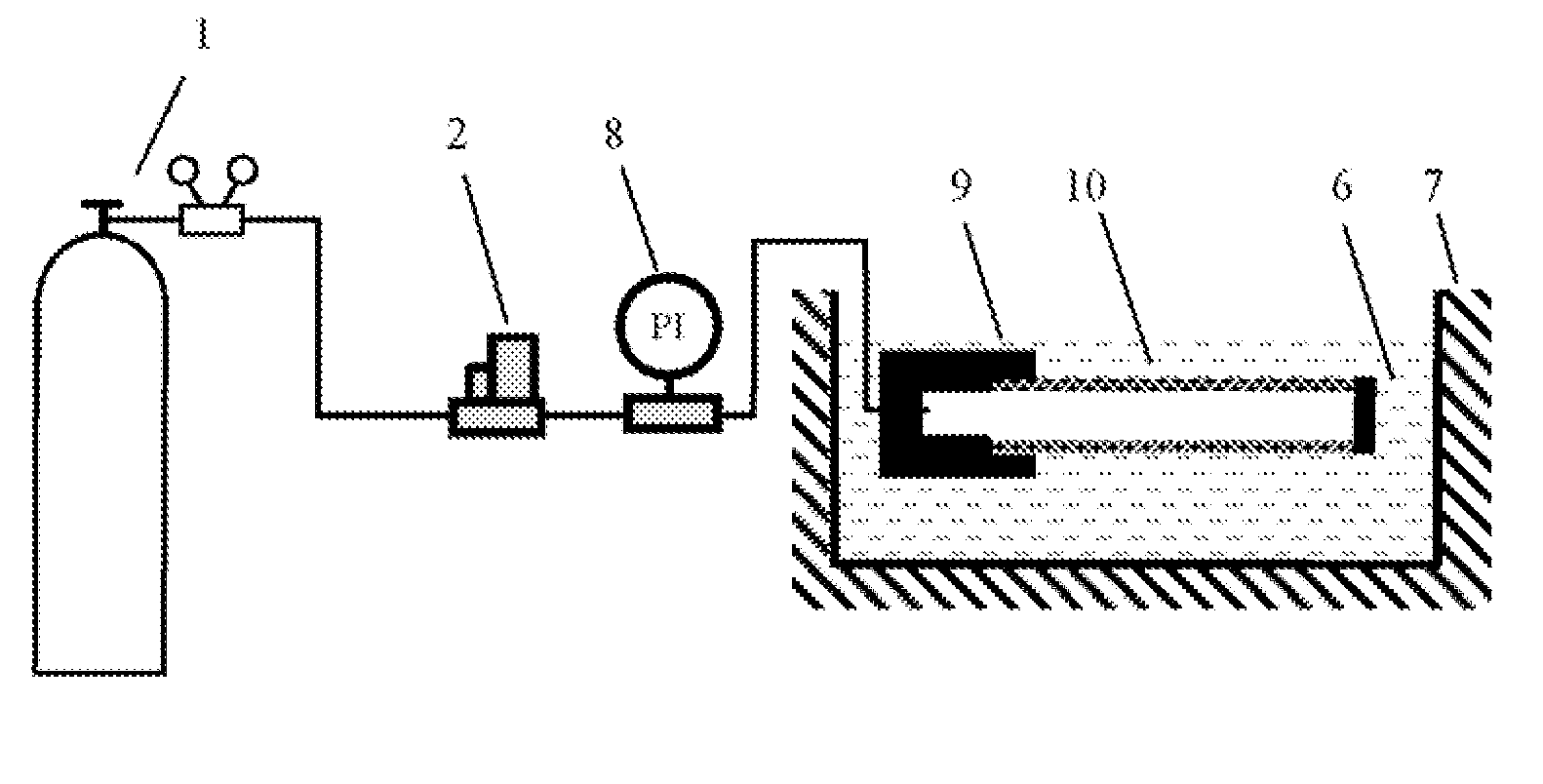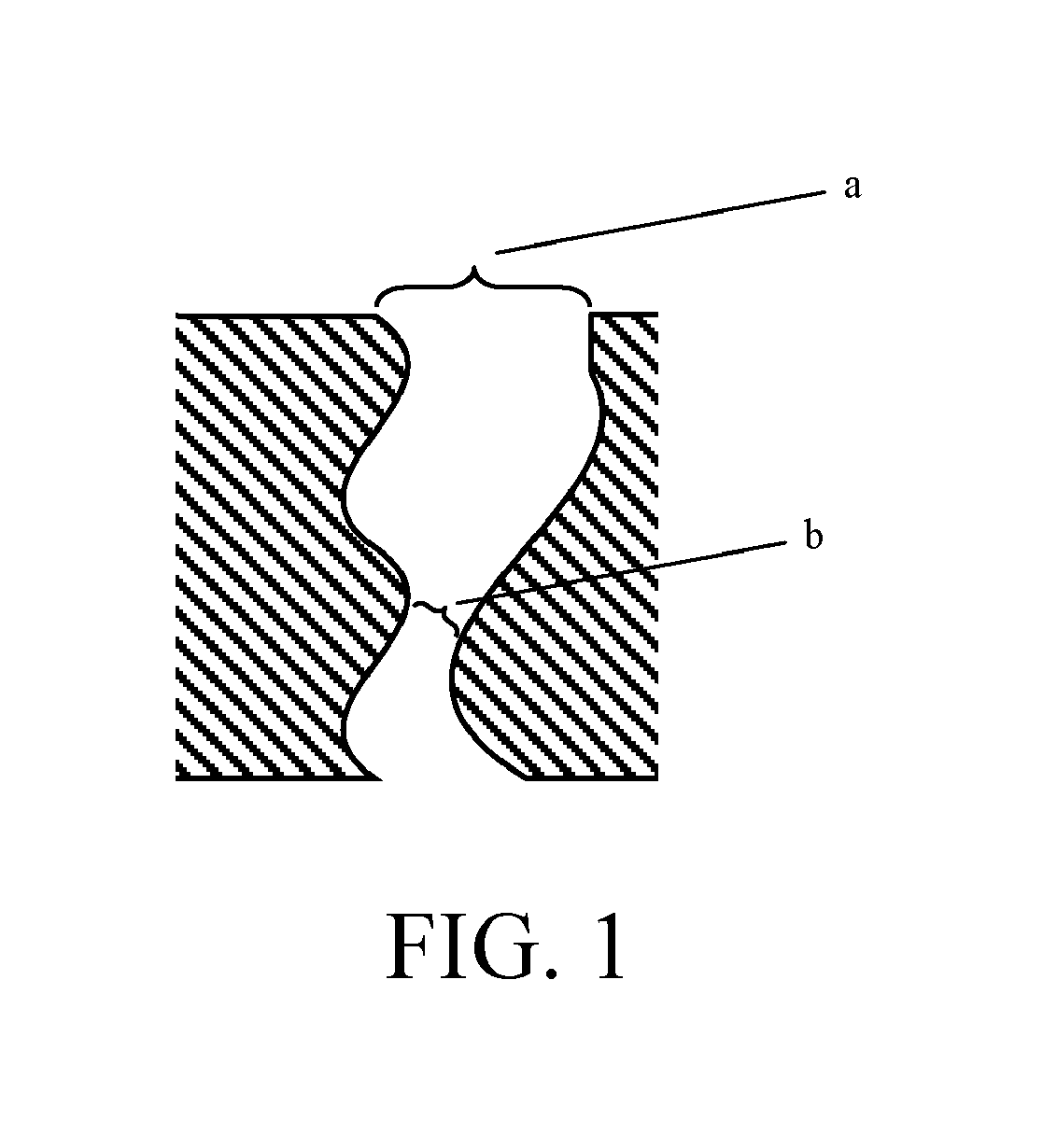Method of Determining Surface Pore Mouth Diameter Distribution of Porous Material
a technology of porous materials and pore mouths, which is applied in the direction of permeability/surface area analysis, suspension and porous material analysis, instruments, etc., can solve the problems of reducing the consumption of noble metals, pore size, and too low mechanical strength of pd membranes, and achieves simple operation, convenient for the detection of products, and easy construction
- Summary
- Abstract
- Description
- Claims
- Application Information
AI Technical Summary
Benefits of technology
Problems solved by technology
Method used
Image
Examples
embodiment 1
[0028]i. A sample to be tested was a porous ceramic sheet having a diameter of 30 mm and a thickness of 2 mm. The sample was washed with 1 ml / L of a diluted HCl solution followed by DI water for about 5 min, and dried.
[0029]ii. The testing device, as shown in FIG. 2, was composed of a compressed gas cylinder (1), a mass flowmeter (2), a pressure gauge (3), a sample cell (4), a sample (5), and a water tank (7). The sample was placed into the sample cell (4) with the surface to be tested facing outwards, and two sides were respectively sealed by an annular silicone rubber pad with an outer diameter of 30 mm, an inner diameter of 10 mm and a thickness of 2 mm. The mass flowmeter (2) was regulated to gradually increase the gas flow rate from zero, and the gas flow rate and the pressure were recorded. When the flow rate was 5 L / min, the pressure was 184 kPa. At this time, the flow rate was plotted against the pressure to give a dry curve, and half of the flow rate was plotted against the...
embodiment 2
[0032]i. The sample was a SS-316L stainless steel membrane with a gradient pore structure having a diameter of 30 mm and a thickness of 2 mm, composed of a macroporous support and a pore-size controller with a thickness of 200 μm. The sample was washed with 1 ml / L of a diluted HCl solution, a 0.5 mol / L diluted NaOH solution, and then DI water for about 5 min, and dried.
[0033]ii. In this case, the membrane surface of the sample with a small pore size was to be measured. The determination for the data of the dry curve, half-dry curve, and wet curve were the same as those in the steps (ii), (iii) and (iv) of Embodiment 1, and the results are shown in FIG. 5. The mean pore size and the maximum pore size of the surface pore mouth of the membrane were measured to be 13.9 μm and 62.1 μm respectively.
[0034]iii. The mean pore size and the maximum pore size of the pore throat of the sample were measured in the same manner as the step (v) of Embodiment 1, and were 9.1 μm and 41.7 μm respective...
embodiment 3
[0035]i. The sample to be tested was the same as that in Embodiment 2, except that the support side of the sample was to be measured.
[0036]ii. Other operations were the same as those in Embodiment 2. The results are shown in FIG. 6. The mean pore size and the maximum pore size of the surface pore mouth of the support were measured to be 64.8 μm and 171.5 μm respectively.
[0037]iii. It can be seen from the results of Embodiments 2 and 3 that, the pore size of the support surface is much larger than that of the membrane surface for the same sample, which conforms to the actual situation of the sample, and indicates that this method is reasonable.
PUM
| Property | Measurement | Unit |
|---|---|---|
| thickness | aaaaa | aaaaa |
| gas pressure | aaaaa | aaaaa |
| gas pressure | aaaaa | aaaaa |
Abstract
Description
Claims
Application Information
 Login to View More
Login to View More - R&D
- Intellectual Property
- Life Sciences
- Materials
- Tech Scout
- Unparalleled Data Quality
- Higher Quality Content
- 60% Fewer Hallucinations
Browse by: Latest US Patents, China's latest patents, Technical Efficacy Thesaurus, Application Domain, Technology Topic, Popular Technical Reports.
© 2025 PatSnap. All rights reserved.Legal|Privacy policy|Modern Slavery Act Transparency Statement|Sitemap|About US| Contact US: help@patsnap.com



